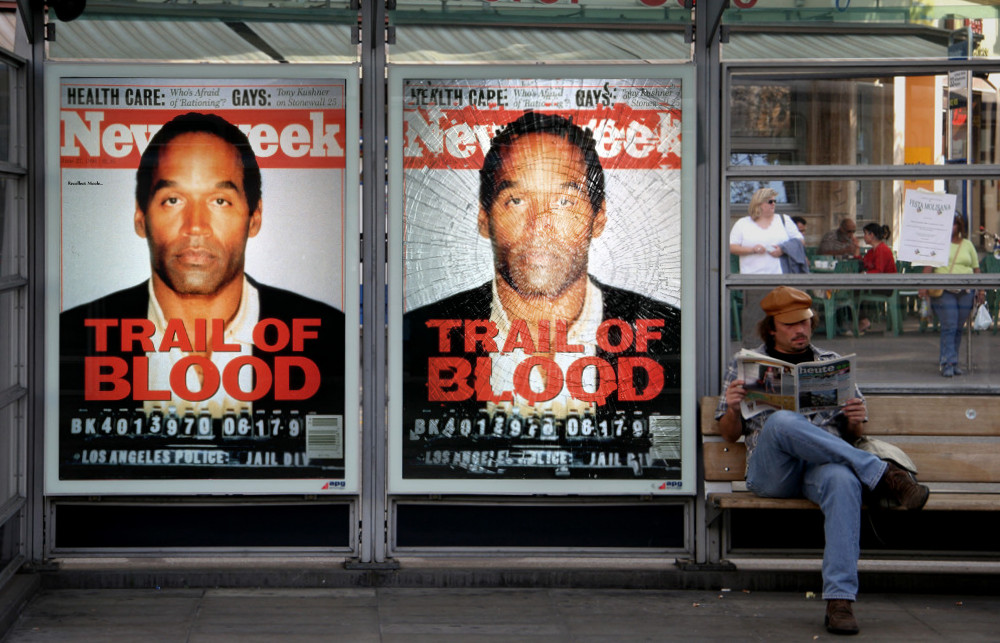The end, last week, was off-camera.
After the bloody steps, the heart-rending funerals, the surreal chase through the twilight of Los Angeles, O.J. Simpson surrendered himself into the darkness his life has become.
It was a peaceful end, a surprisingly peaceful end, to a week that was drenched in trauma, tension and blood.

On Sunday night, O.J.’s ex-wife Nicole Brown Simpson and her friend, a young waiter-model named Ronald Goldman, were stabbed to death outside her $650,000 town house.
Almost from the moment their bodies were found less than two hours later, as crumpled and porous as Caesar’s, suspicion focused on O.J.
With the help of his star-quality dignity and heavy doses of sedatives, he led his two young children through Nicole’s funeral service, holding each by hand, his eyes shielded by sunglasses. By Friday, after collecting piles of evidence and leaking much of it to the press, Los Angeles police officials were ready to arrest him.
O.J.’s lawyer was going to bring him in. Only, O.J. fled, accompanied by his lifelong friend and all-purpose aide, Al Cowlings, who was doing Simpson one last service.
Last week’s murders brought a brutal end to a turbulent relationship.
Nicole Brown was 18 years old when she met Simpson in 1977. Homecoming Queen at Dana Hills High School in Dana Point, she worked part time after graduation as a waitress at The Daisy, a Beverly Hills nightclub. Within a year they were living together.
Simpson and Brown were married six years later, under a tent at his Brentwood Park estate.
They made a dazzling couple, and his income underwrote an opulent life-style that included twin Ferraris, gambling trips to Vegas, skiing jaunts in Aspen, Colorado and summers at an oceanfront house in Laguna Beach, California.
But some feared that the good times papered over serious problems.

“There were hints,” one close friend of Nicole Simpson’s told NEWSWEEK.
“It was physically obvious. She had marks, red marks on her wrists. I saw them on two or three occasions.
There were no scratches or black eyes and it wasn’t a daily kind of thing.
Everybody knew and every once in a while she’d say things to friends.”
The violence spilled into public view in early 1989.
At about 3.30am on New Year’s Day, police answered a 911 call from Nicole Simpson. The assault had little impact on his lucrative career in commercial endorsements.
Nicole Simpson filed for divorce in March 1992, citing “irreconcilable differences”. O.J. had completed his probation without incident. But court findings examined by NEWSWEEK suggest that she still may have considered herself at risk.
A miscellaneous provision of the settlement states: “Each party shall have the right to live separate and apart from the other, free from any interference or harassment”
The picture of their life after the divorce remain muddled. O.J. and Nicole continued to see each other, attending fund-raisers and other high-profile functions together.
But police said last week that 911 calls from Nicole complaining about her ex-husband were an “ongoing problem”.
Nicole Simpson’s transition to single life seemed less troubled. Her entire work history, beyond her two-month waitressing stint, was two weeks as a boutique sales-clerk. But the divorce settlement allowed her to live well without a job.
She decorated the $650,000 town house with Lalique crystal figures and a large, colorful, modern painting. In a loft overlooking the living room was a StairMaster.
Acquaintances say she was a good mother with a cheerful personality, a familiar figure to shopkeepers and joggers along San Vicente Boulevard.
She worked out frequently at The Gym, a neighborhood health club, and on many evenings she hired a babysitter so she could go dancing with friends at clubs in Santa Monica, West Hollywood and Beverly Hills.
It’s not clear when or how Ron Goldman came into her life.

They might have met at The Gym, or Mezzaluna, a Brentwood Restaurant where he waited tables and she like to dine.
He was 25, 10 years her junior, with sculpted good looks and a penchant for bragging about his sexual conquests.
It will likely be months before a trial, but the bizarre swing of public sympathy towards Simpson worries officials.
District Attorney Gil Garcetti said he is concerned that defence attorneys “may find one juror who will not follow the law,” setting Simpson free.
While he says he understands the empathy for a fallen hero, he cautions against “losing sight that it is Nicole Brown Simpson and Ronald Lyle Goldman who are the true victims.”
Garcetti is right about that, at least, but the reality is that long after their names are footnotes, it is Simpson’s name that will resonate, along with the memory of his run to an astonishing fate.
Newsweek Magazine (June 27 1994)

